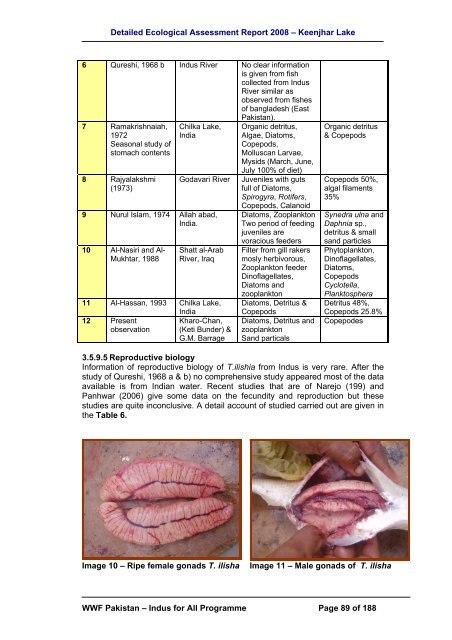Disclaimer note - WWF - Pakistan
Disclaimer note - WWF - Pakistan
Disclaimer note - WWF - Pakistan
Create successful ePaper yourself
Turn your PDF publications into a flip-book with our unique Google optimized e-Paper software.
Detailed Ecological Assessment Report 2008 – Keenjhar Lake<br />
6 Qureshi, 1968 b Indus River No clear information<br />
is given from fish<br />
collected from Indus<br />
River similar as<br />
observed from fishes<br />
of bangladesh (East<br />
7 Ramakrishnaiah,<br />
1972<br />
Seasonal study of<br />
stomach contents<br />
8 Rajyalakshmi<br />
(1973)<br />
Chilka Lake,<br />
India<br />
9 Nurul Islam, 1974 Allah abad,<br />
India.<br />
10 Al-Nasiri and Al-<br />
Mukhtar, 1988<br />
<strong>Pakistan</strong>).<br />
Organic detritus,<br />
Algae, Diatoms,<br />
Copepods,<br />
Molluscan Larvae,<br />
Mysids (March, June,<br />
July 100% of diet)<br />
Godavari River Juveniles with guts<br />
full of Diatoms,<br />
Spirogyra, Rotifers,<br />
Shatt al-Arab<br />
River, Iraq<br />
11 Al-Hassan, 1993 Chilka Lake,<br />
India<br />
12 Present<br />
Kharo-Chan,<br />
observation (Keti Bunder) &<br />
G.M. Barrage<br />
Copepods, Calanoid<br />
Diatoms, Zooplankton<br />
Two period of feeding<br />
juveniles are<br />
voracious feeders<br />
Filter from gill rakers<br />
mosly herbivorous,<br />
Zooplankton feeder<br />
Dinoflagellates,<br />
Diatoms and<br />
zooplankton<br />
Diatoms, Detritus &<br />
Copepods<br />
Diatoms, Detritus and<br />
zooplankton<br />
Sand particals<br />
Organic detritus<br />
& Copepods<br />
Copepods 50%,<br />
algal filaments<br />
35%<br />
Synedra ulna and<br />
Daphnia sp.,<br />
detritus & small<br />
sand particles<br />
Phytoplankton,<br />
Dinoflagellates,<br />
Diatoms,<br />
Copepods<br />
Cyclotella,<br />
Planktosphera<br />
Detritus 48%,<br />
Copepods 25.8%<br />
Copepodes<br />
3.5.9.5 Reproductive biology<br />
Information of reproductive biology of T.ilishia from Indus is very rare. After the<br />
study of Qureshi, 1968 a & b) no comprehensive study appeared most of the data<br />
available is from Indian water. Recent studies that are of Narejo (199) and<br />
Panhwar (2006) give some data on the fecundity and reproduction but these<br />
studies are quite inconclusive. A detail account of studied carried out are given in<br />
the Table 6.<br />
Image 10 – Ripe female gonads T. ilisha Image 11 – Male gonads of T. ilisha<br />
<strong>WWF</strong> <strong>Pakistan</strong> – Indus for All Programme Page 89 of 188

















